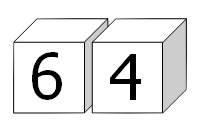* feat(tools): add seed/solution restore script * chore(curriculum): remove empty sections' markers * chore(curriculum): add seed + solution to Chinese * chore: remove old formatter * fix: update getChallenges parse translated challenges separately, without reference to the source * chore(curriculum): add dashedName to English * chore(curriculum): add dashedName to Chinese * refactor: remove unused challenge property 'name' * fix: relax dashedName requirement * fix: stray tag Remove stray `pre` tag from challenge file. Signed-off-by: nhcarrigan <nhcarrigan@gmail.com> Co-authored-by: nhcarrigan <nhcarrigan@gmail.com>
2.1 KiB
id, title, challengeType, forumTopicId, dashedName
| id | title | challengeType | forumTopicId | dashedName |
|---|---|---|---|---|
| 5900f3c61000cf542c50fed9 | Problem 90: Cube digit pairs | 5 | 302207 | problem-90-cube-digit-pairs |
--description--
Each of the six faces on a cube has a different digit (0 to 9) written on it; the same is done to a second cube. By placing the two cubes side-by-side in different positions we can form a variety of 2-digit numbers.
For example, the square number 64 could be formed:

In fact, by carefully choosing the digits on both cubes it is possible to display all of the square numbers below one-hundred: 01, 04, 09, 16, 25, 36, 49, 64, and 81.
For example, one way this can be achieved is by placing {0, 5, 6, 7, 8, 9} on one cube and {1, 2, 3, 4, 8, 9} on the other cube.
However, for this problem we shall allow the 6 or 9 to be turned upside-down so that an arrangement like {0, 5, 6, 7, 8, 9} and {1, 2, 3, 4, 6, 7} allows for all nine square numbers to be displayed; otherwise it would be impossible to obtain 09.
In determining a distinct arrangement we are interested in the digits on each cube, not the order.
{1, 2, 3, 4, 5, 6} is distinct from {1, 2, 3, 4, 5, 9}
But because we are allowing 6 and 9 to be reversed, the two distinct sets in the last example both represent the extended set {1, 2, 3, 4, 5, 6, 9} for the purpose of forming 2-digit numbers.
How many distinct arrangements of the two cubes allow for all of the square numbers to be displayed?
--hints--
cubeDigitPairs() should return a number.
assert(typeof cubeDigitPairs() === 'number');
cubeDigitPairs() should return 1217.
assert.strictEqual(cubeDigitPairs(), 1217);
--seed--
--seed-contents--
function cubeDigitPairs() {
return true;
}
cubeDigitPairs();
--solutions--
// solution required